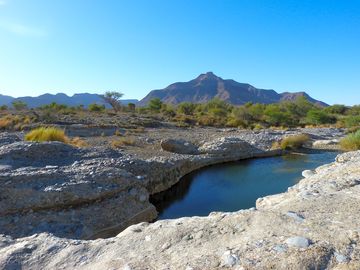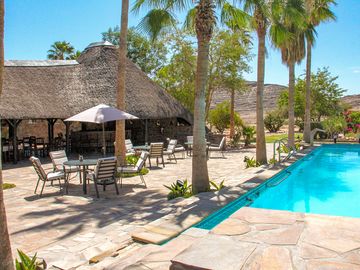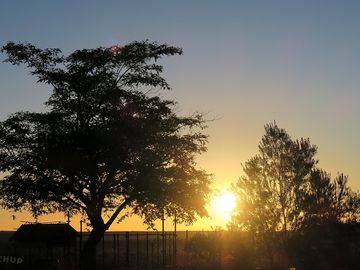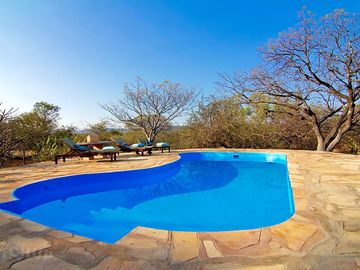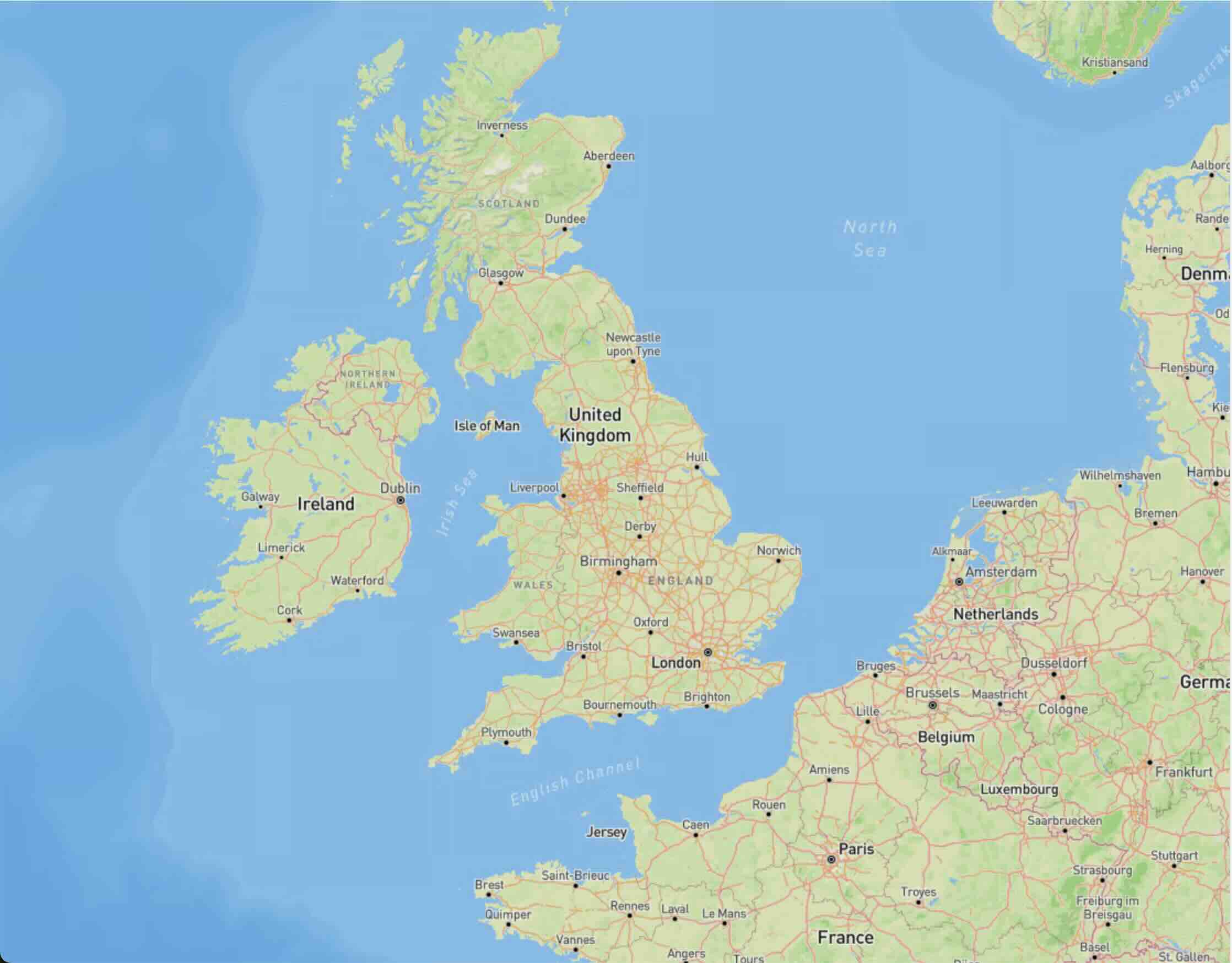There’s a saying in some parts: ‘You cry twice in Namibia. First when you arrive and then again when you leave.’ Whether this is your first trip to Africa or you’re making a welcome return, choosing stays in Namibia will always be tear-filled – in the best possible way.
People call this southern country ‘Africa for beginners’ and, even at a glance, it’s easy to see why. Namibia is home to the Big Five, to glorious sunsets and a host of wineries, to rock art and ship graveyards, and to a wildly varied landscape that has everything from deserts to lush national parks.
There’s no bad time to visit Namibia either – the country has an average of 300 days of sunshine every year – but adventurers may do well to travel in the season that suits temperature requirements best.
Namibian climate
This is the southern hemisphere, so winter is July and August, and summer is December and January. At its hottest, expect days to be between 17 and 32 degrees Celsius. At its coolest? Between 7 and 22 degrees. There’s low humidity and infrequent rain year-round, though the rainy season (January to April) gets its fair share of thundershowers, and the further northeast you go, the more rain you’re likely to see.
Travel season settled on, now turn thoughts to how you’re going to spend your time in Namibia. The options are plentiful, though perhaps you’re best off starting with the big-name attractions.
Namibian sightseeing
Along the country’s coast (in the west) lies the Namib desert, generally considered to be the oldest desert in the world at around 55 million years old. Within the Namib are Sossuvlei and Deadvlei, former marshes that are now spectacularly scenic desert landscapes.
Sossuvlei is best known for its vividly coloured sand dunes, some of which are as high as 383 metres (finding out which of the dunes can be climbed, and being sure to reach their peak by sunrise or sunset, comes highly recommended), while Deadvlei’s reputation is built on the stark image of its its dried-out (but living) 1,000-year-old trees against the white sand, red dunes and brilliant blue skies.
The Namib desert is also home to the world’s biggest grave site for sailors and ships, which you’re of course free to explore. The Skeleton Coast is a notoriously dangerous stretch for seafarers, with unrelenting fog and hidden offshore rocks. More than a thousand unlucky craft have been shipwrecked along the northwestern reaches of the Namibian coast.
That’s far from the end of Namibia’s natural sites… The southern end of the mountainous ridge that forms the country’s back bone is dominated by Fish River Canyon – thought to be the second largest canyon in the world, and a stunningly scenic rival to the United States’ Grand Canyon. (Camera absolutely required.)
Namibian safaris and wildlife
If travel to Africa has been inspired by thoughts of animal-based adventure, you won’t be disappointed here. Namibia is home to Africa’s largest game park (Namib-Naukluft National Park), is one of the few countries that still has black and white rhinos, has one of the largest populations of black rhinos in the world, and has the world’s largest population of free-roaming cheetahs.
Anyone keen on ticking the Big Five – lions, cheetahs, rhinos, elephants and buffalo – off lists should make immediate tracks for Etosha National Park. The park, which is a giant salt flat, is literally the size of Switzerland, and visitors should handily spot the first four of the Big Five, especially by hanging about near watering holes in the otherwise dry park. Buffalo are a tougher spot, but a trip to the nearby Waterberg Plateau should sort that.
Trips to the lush Caprivi Strip in the country’s northeast are a must too. A relatively narrow strip of land along the Zambezi river (which connects the country to the spectacular Victoria Falls), it’s got more than a handful of national parks to its name and is a prime spot for spying out Cape Buffalo and hippopotami.
Prefer to try for a different type of wildlife? Spend time among the bouldered mountains and snaking dry valleys of Damaraland where – as well as bizarrely photogenic trees – lucky visitors will encounter desert-adapted elephants, desert lions and Africa’s largest population of free-ranging rhinos, or turn back to the coast and the Cape Cross Seal Reserve where you’ll almost certainly come across at least one of the more than 100,000 Cape fur seals in residence.
There are plenty of private reserves dotted throughout the country, with Erindi and Okonjima being among the more famous. Head to the latter for visits to AfriCat Foundation, a rehab facility for cheetahs.
Namibian culture and history
Namibia has a remarkably low population density, which makes for rather peaceful hols far from the madding crowds. It also makes for rather splendid stargazing as, particularly around Spitzkoppe peaks and in the desert, there’s very little pollution – air or light – to get between you and the heavens.
It’s an incredibly diverse population though, when you do encounter it, with 13 officially recognised languages (three of which are European and 10 of which are indigenous) and some 30 languages spoken throughout the country. There’s a rich cultural history to explore here too. Namibia has one of the highest concentrations of rock art in Africa, and the UNESCO-listed Twyfelfontein is a must-visit with more than 2,000 pieces of rock art and carvings, some up to 6,000 years old.
Namibian urban centres
To spend some time in busier population centres, there are some quite large cities you might like to turn attentions to, each of which is full of stunning architecture and museums that tell the age-old story of colonial settlement and oppression.
Namibia’s capital, Windhoek, is almost precisely in the middle of the country, and has a zoo, gardens, the national gallery and national museum, and lots else that should entice. It’s arguably the most ‘Western’ city in the country, and tiptoes along the line between modern life and traditional Africa.
Lüderitz – a coastal city in the south, standing between the chilly South Atlantic Ocean and the blisteringly hot Namib Desert – is viewed by many as a ‘mini Deutschland’, full of German art-nouveau architecture, restaurants serving sausage and sauerkraut, and bars serving weiss beers.
Swakopmund, on a coastal spot roughly parallel with Windhoek, is a fancier affair. Again, you have the German art nouveau architecture (with seaside promenades and colonial-era buildings), paired this time with feats of derring-do, as the city is a starting point for skydiving, sandboarding and horseriding.
Where to stay in Namibia
So, now that you realise just how much there is to see in Namibia, how on earth are you going to narrow down which part of the country to base yourself in on hols?
Well, it’s simple.
Head to the west for the Namib desert (and its spectacular Deadvlei and Sossuvlei), the Skeleton Coast, the Cape Cross Seal Reserve, Namib-Naukluft National Park, Damaraland, Spitzkoppe and Twyfelfontein.
Make your way north for Etosha National Park, the Waterberg Plateau, Erindi and Okonjima reserves (and AfriCat), the Caprivi Strip and the Zambezi river.
If it’s spectacular scenery you want, it’s south you should be looking, with Fish River Canyon and the pretty Lüderitz to entertain you.
Have more of a city stay in mind? Keep it central. That’s where Windhoek is, making it handily, well…central to the rest of Namibia.
